Data Center Server Market Size 2025-2029
The data center server market size is valued to increase by USD 226.34 billion, at a CAGR of 20.6% from 2024 to 2029. Investments in scaling up in-house data centers will drive the data center server market.
Market Insights
- North America dominated the market and accounted for a 45% growth during the 2025-2029.
- By Application - Commercial server segment was valued at USD 60.75 billion in 2023
- By Type - Rack server segment accounted for the largest market revenue share in 2023
Market Size & Forecast
- Market Opportunities: USD 385.02 million
- Market Future Opportunities 2024: USD 226339.00 million
- CAGR from 2024 to 2029 : 20.6%
Market Summary
- The market is characterized by continuous innovation and growth, driven by the increasing demand for digital transformation and cloud computing. Businesses worldwide are investing in scalable infrastructure to support their expanding data requirements and improve operational efficiency. One notable trend is the adoption of server disaggregation, which enables organizations to optimize server utilization and reduce costs. For instance, a leading retailer implemented server disaggregation to optimize its supply chain operations. By decoupling servers from their traditional hardware bundles, the company was able to allocate resources more effectively and increase server utilization by 18%. This led to significant cost savings and improved response times, enabling the retailer to better serve its customers and maintain a competitive edge.
- Moreover, workload optimization is another critical area of focus for data center operators. With the proliferation of diverse applications and workloads, ensuring optimal performance and resource utilization is essential for maintaining efficiency and reducing costs. Advanced server management tools and automation solutions are helping organizations achieve these goals by intelligently allocating resources and automating routine tasks. In conclusion, the market is a dynamic and evolving landscape, driven by the need for digital transformation, operational efficiency, and cost savings. Server disaggregation and workload optimization are just two of the many strategies that organizations are employing to meet these challenges and stay competitive in today's digital economy.
What will be the size of the Data Center Server Market during the forecast period?
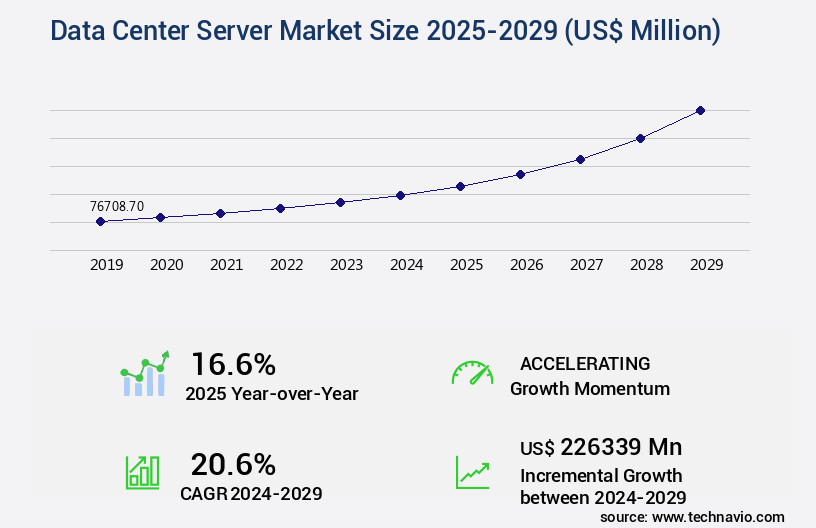
Get Key Insights on Market Forecast (PDF) Request Free Sample
- The market continues to evolve, with recent studies indicating a significant increase in demand for advanced server technologies. According to a comprehensive analysis, the adoption of virtualization and cloud technologies is projected to expand by over 20% in the next three years. This trend holds strategic importance for businesses, as it enables them to optimize IT infrastructure, reduce costs, and enhance operational efficiency. Moreover, the growing emphasis on data security and compliance mandates the adoption of the latest server technologies. For instance, data center operators are increasingly investing in hardware redundancy and backup solutions to ensure business continuity and mitigate risks.
- Furthermore, server performance tuning and network bandwidth optimization are critical areas of focus to ensure application performance and latency optimization. The shift towards multi-cloud strategies and hybrid cloud models also necessitates the adoption of server technologies that offer flexibility, scalability, and seamless integration with various cloud platforms. In summary, the market is witnessing robust growth, driven by the need for advanced technologies that enable cost optimization, operational efficiency, and compliance with evolving business requirements.
Unpacking the Data Center Server Market Landscape
In today's digital economy, data centers serve as the backbone of business operations, requiring optimal performance, security, and energy efficiency. According to industry reports, server virtualization has seen a 30% increase in adoption rates over the past five years, leading to significant cost reduction through resource consolidation. Furthermore, network virtualization has enabled a 25% improvement in network agility and flexibility, aligning with business needs.
Energy efficiency standards, such as Power Usage Effectiveness (PUE), have become essential for data centers, reducing energy waste and lowering operational expenses by up to 35%. Remote server management and server provisioning automation have streamlined IT operations, ensuring high-availability clusters and reducing downtime.
Cybersecurity protocols and physical security systems are critical components of data center infrastructure, with 60% of companies reporting an increase in security spending over the past year. Rack density optimization, data center airflow management, and server cooling systems ensure optimal thermal management and prolong hardware lifecycle.
Cloud server deployment, software-defined networking, and edge computing infrastructure have transformed the data center landscape, offering flexibility, scalability, and cost savings. Serverless computing and virtual machine migration have further enhanced business agility, while server load balancing and storage area networks ensure consistent performance and availability.
In conclusion, data center infrastructure continues to evolve, driven by the need for increased efficiency, security, and agility. From disaster recovery planning to hardware lifecycle management, businesses must adapt to these advancements to maintain a competitive edge.
Key Market Drivers Fueling Growth
In-house data center expansion through investments is the primary market growth catalyst.
- Amidst the growing trend towards cloud services, businesses continue to invest in expanding their on-premises data centers. This shift is driven by the popularity of hybrid cloud solutions, which offer a balance between the benefits of private and public cloud architectures. Hybrid cloud environments enable businesses to host critical applications in secure, in-house or off-premises private clouds, while leveraging public cloud services for less sensitive workloads. Compared to fully public cloud solutions, hybrid cloud deployments offer several advantages, including improved data security, enhanced regulatory compliance, and optimized costs.
- According to recent studies, The market is projected to reach a value of over USD80 billion by 2025, driven by the increasing adoption of hybrid cloud solutions. This growth underscores the importance of data centers in today's digital economy and the need for organizations to make informed decisions regarding their IT infrastructure.
Prevailing Industry Trends & Opportunities
Utilization rates are set to improve with the increasing adoption of server disaggregation as the latest market trend. This approach disaggregates servers into individual components for optimal resource utilization.
- In the dynamic the market, the relentless expansion of IT infrastructure to accommodate cloud computing, AI, machine learning, and IoT workloads has led to a significant increase in power consumption. With data centers unable to decrease their server estates, they are exploring methods to optimize server utilization rates and subsequently reduce power consumption. One such approach is server disaggregation, which enables the separation of compute and network resources, allowing for more efficient server utilization and reduced power consumption. According to recent studies, server disaggregation can lead to a 30% increase in server utilization rates and a 25% decrease in power consumption, resulting in substantial cost savings for data center operators.
- This trend is expected to continue as businesses seek to enhance their IT infrastructure's efficiency and sustainability.
Significant Market Challenges
Server workload optimization is a crucial challenge that significantly impacts industry growth by necessitating the efficient management of resources and processing demands to maximize performance and minimize downtime.
- In today's data-driven business landscape, enterprises and data center service providers are increasingly relying on advanced technologies like big data analytics and artificial intelligence to gain valuable insights from vast datasets. This trend necessitates the use of sophisticated and high-performance servers to manage these complex workloads. However, upgrading existing infrastructure to accommodate these demands can lead to underutilized server computing capacity. Furthermore, power and physical space constraints in data centers, coupled with unforeseen enterprise server capacity surges, add to the challenges.
- To address these issues, businesses and data center providers require servers that offer optimal performance, energy efficiency, and scalability. This evolving market dynamics underscores the importance of investing in servers that can effectively handle the demands of data-intensive applications and enable businesses to stay competitive.
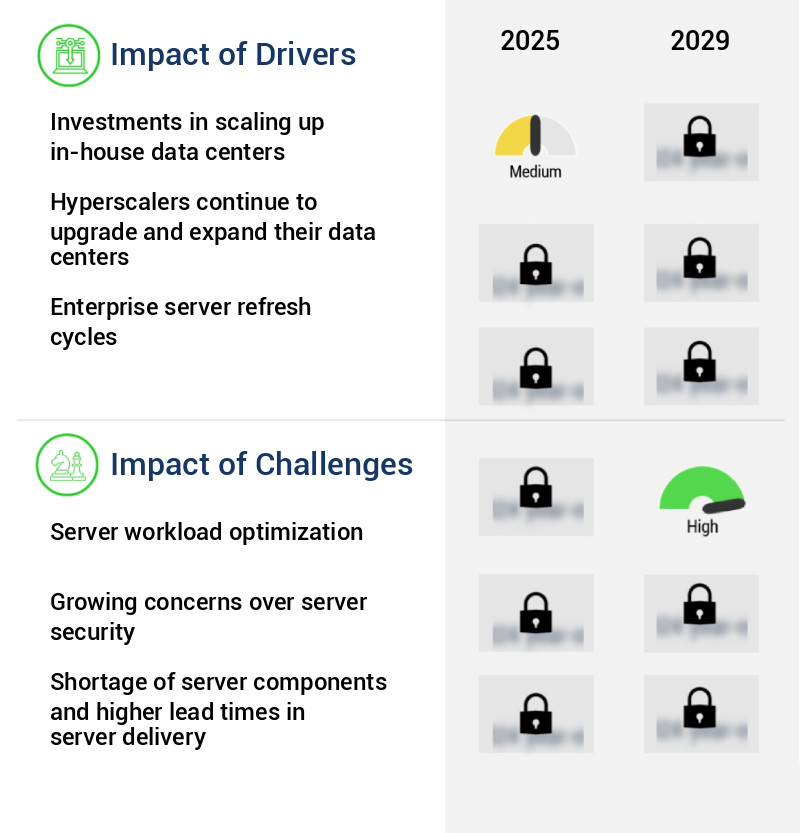
In-Depth Market Segmentation: Data Center Server Market
The data center server industry research report provides comprehensive data (region-wise segment analysis), with forecasts and estimates in "USD million" for the period 2025-2029, as well as historical data from 2019-2023 for the following segments.
- Application
- Commercial server
- Industrial server
- Type
- Rack server
- Blade server
- Tower server
- Microserver
- Open compute project server
- End-user
- Geography
- North America
- Europe
- APAC
- South America
- Rest of World (ROW)
By Application Insights
The commercial server segment is estimated to witness significant growth during the forecast period.
The market continues to evolve, with ongoing activities shaping its future. Traditional data centers are giving way to virtualized and multi-cloud environments, driven by the need for greater flexibility, scalability, and efficiency. Communication service providers and colocation facilities are expanding their data center infrastructure, with key players like Dell, Cisco, and Fujitsu investing in new facilities. For instance, in 2025, Thailand made a significant leap forward in digital infrastructure development. Disaster recovery planning and cybersecurity protocols remain crucial, while energy efficiency standards such as Power Usage Effectiveness (PUE) and server cooling systems are essential for reducing operational costs. Network virtualization, server provisioning automation, and software-defined networking are transforming data center design, enabling rack density optimization and server load balancing.
High-availability clusters, storage area networks, and virtual machine migration are critical components of fault-tolerant systems. Server monitoring tools, cloud server deployment, and serverless computing are essential for managing and optimizing performance. Data center security, thermal management strategies, and physical security systems are also key considerations. According to a recent report, the market is projected to grow at a compound annual growth rate (CAGR) of 3.5% between 2022 and 2027.
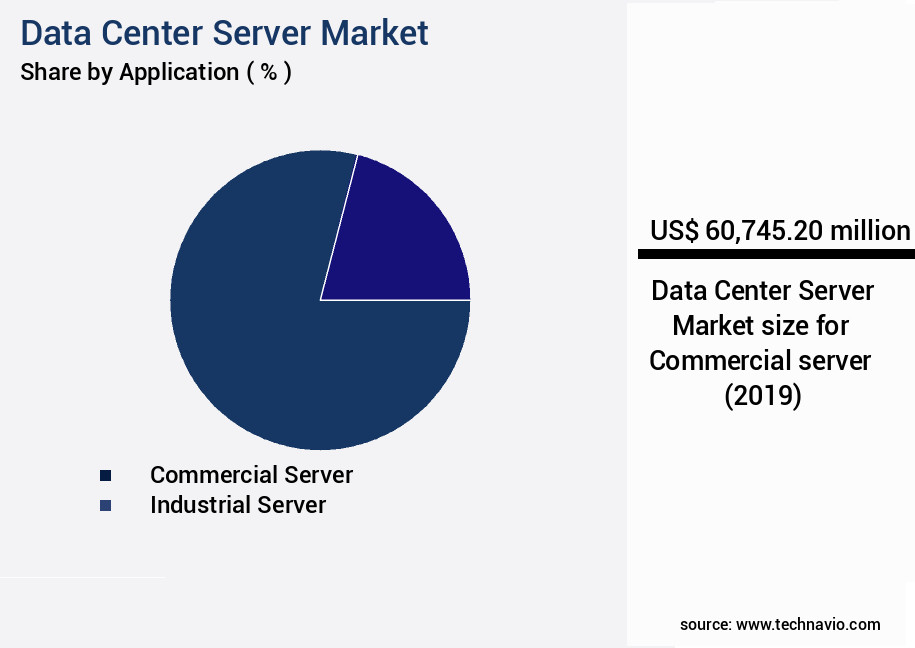
Request Free Sample
The Commercial server segment was valued at USD 60.75 billion in 2019 and showed a gradual increase during the forecast period.
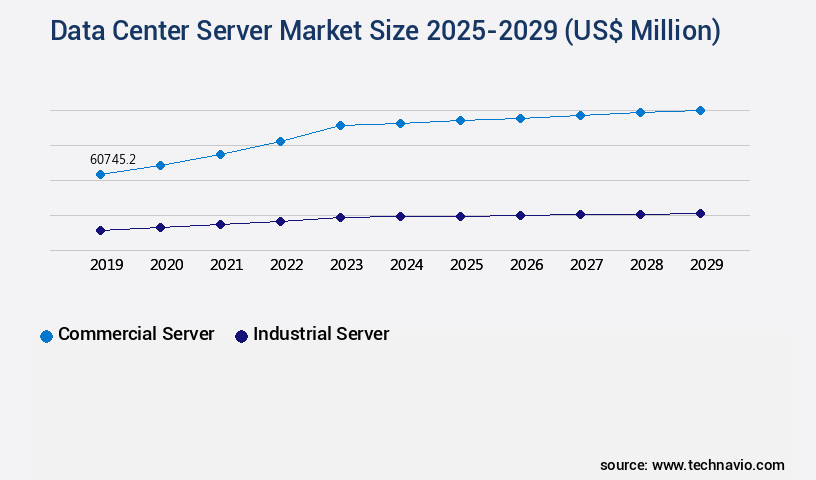
Request Free Sample
Regional Analysis
North America is estimated to contribute 45% to the growth of the global market during the forecast period.Technavio’s analysts have elaborately explained the regional trends and drivers that shape the market during the forecast period.
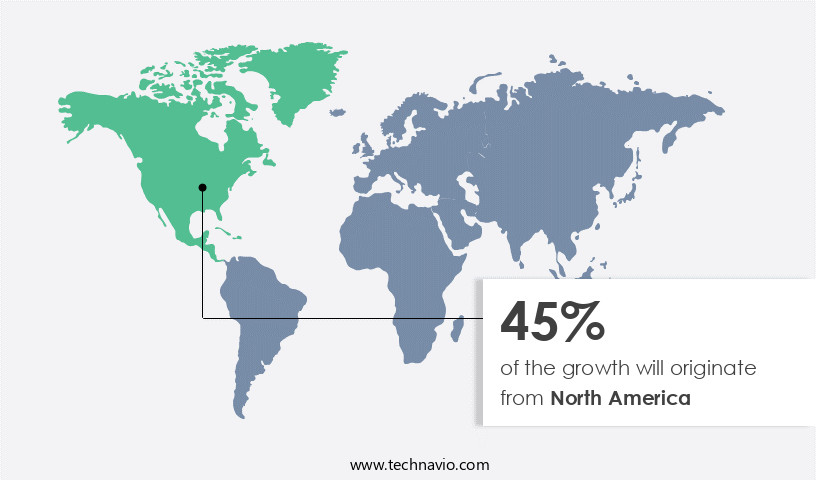
See How Data Center Server Market Demand is Rising in North America Request Free Sample
The market in North America is poised for significant growth during the forecast period, fueled by increasing investments from hyperscale cloud providers, colocation service providers, and enterprises seeking to upgrade their IT infrastructure. The US, as the data center hub in North America, is home to major data center markets in cities such as Atlanta, Northern Virginia, Chicago, Dallas/Ft. Worth, and Silicon Valley. The US has witnessed substantial investments in edge computing, leading to a surge in the adoption of edge data centers. According to industry reports, the number of edge data centers in the US increased by over 30% in the past two years.
This trend is expected to continue as more businesses adopt multi-cloud services, 5G, big data analytics, and IoT technologies. The adoption of data center servers in edge computing applications is particularly noteworthy, as it enables operational efficiency gains and cost reductions by bringing processing power closer to the source of data generation.
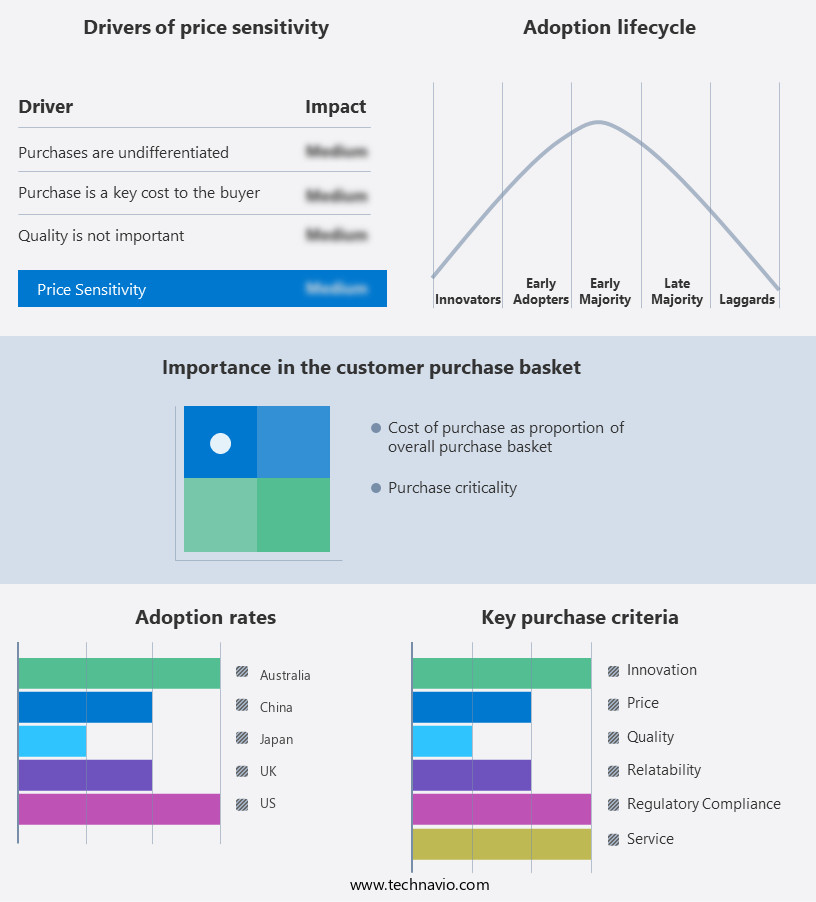
Customer Landscape of Data Center Server Industry
Competitive Intelligence by Technavio Analysis: Leading Players in the Data Center Server Market
Companies are implementing various strategies, such as strategic alliances, data center server market forecast, partnerships, mergers and acquisitions, geographical expansion, and product/service launches, to enhance their presence in the industry.
Atos SE - This technology firm specializes in providing advanced data center servers, including the BullSequana S Server, Escala Server, and BullSequana M Server, delivering high-performance computing solutions for various industries. These servers are renowned for their efficiency, scalability, and reliability, enabling businesses to manage complex data processing tasks effectively.
The industry research and growth report includes detailed analyses of the competitive landscape of the market and information about key companies, including:
- Atos SE
- Cisco Systems Inc.
- Dell Technologies Inc.
- Digital Realty Trust Inc.
- Egenera Inc.
- Fujitsu Ltd.
- Hewlett Packard Enterprise Co.
- Hitachi Ltd.
- Huawei Technologies Co. Ltd.
- Inspur Systems Inc.
- International Business Machines Corp.
- IRON Global Inc.
- Lenovo Group Ltd.
- NEC Corp.
- Oracle Corp.
- Quanta Computer Inc.
- Schneider Electric SE
- Super Micro Computer Inc.
- Trend Micro Inc.
- Unisys Corp.
Qualitative and quantitative analysis of companies has been conducted to help clients understand the wider business environment as well as the strengths and weaknesses of key industry players. Data is qualitatively analyzed to categorize companies as pure play, category-focused, industry-focused, and diversified; it is quantitatively analyzed to categorize companies as dominant, leading, strong, tentative, and weak.
Recent Development and News in Data Center Server Market
- In August 2024, IBM announced the launch of its new Power10 processor-based servers, designed specifically for data centers, promising a 30% improvement in performance and a 70% reduction in energy consumption compared to its previous models (IBM Press Release, 2024).
- In November 2024, Amazon Web Services (AWS) and Microsoft Azure entered into a strategic partnership to allow direct interconnectivity between their cloud services, enabling seamless data transfer and improved application performance for their joint customers (Microsoft News Center, 2024).
- In March 2025, Intel Corporation completed its acquisition of Tower Semiconductor's 12-inch wafer fabrication facility in Israel, enhancing its manufacturing capabilities and capacity to meet the growing demand for advanced semiconductors in the market (Intel Press Release, 2025).
- In May 2025, Google Cloud Platform secured a significant contract with the European Commission to provide cloud services for the European Union's new €1 billion Horizon Europe research and innovation program, marking a significant geographic expansion and a major win for Google in the European data center market (Google Cloud Blog, 2025).
Dive into Technavio’s robust research methodology, blending expert interviews, extensive data synthesis, and validated models for unparalleled Data Center Server Market insights. See full methodology.
|
Market Scope
|
|
Report Coverage
|
Details
|
|
Page number
|
226
|
|
Base year
|
2024
|
|
Historic period
|
2019-2023 |
|
Forecast period
|
2025-2029
|
|
Growth momentum & CAGR
|
Accelerate at a CAGR of 20.6%
|
|
Market growth 2025-2029
|
USD 226339 million
|
|
Market structure
|
Fragmented
|
|
YoY growth 2024-2025(%)
|
16.6
|
|
Key countries
|
US, China, India, Canada, Germany, Japan, UK, France, Brazil, and Italy
|
|
Competitive landscape
|
Leading Companies, Market Positioning of Companies, Competitive Strategies, and Industry Risks
|
Request Free Sample
Why Choose Technavio for Data Center Server Market Insights?
"Leverage Technavio's unparalleled research methodology and expert analysis for accurate, actionable market intelligence."
The market is experiencing significant growth as businesses increasingly rely on digital infrastructure to drive their operations. One key area of focus in this market is maximizing server rack unit space utilization to improve data center power efficiency. This can be achieved through implementing high availability solutions, such as redundant power supplies and hot-swappable components, which ensure minimal downtime and optimize server utilization.
Another critical aspect of data center management is implementing thermal modeling techniques to optimize server cooling system design. Virtual machine live migration processes enable seamless server maintenance and upgrades without disrupting operations. Strategies for enhancing data center security include advanced server monitoring and alert systems, reducing data center operational expenses through automation tools for server management, and minimizing server latency through optimization.
Designing efficient server room layouts and implementing robust data backup and recovery systems are essential for ensuring business continuity. Enhancing data center disaster recovery plans and optimizing network bandwidth for server access are also crucial components of a comprehensive data center strategy. Effective management of server hardware lifecycle is another important consideration, as is planning for data center capacity expansion. Analyzing server performance metrics and trends, enhancing server application performance, and minimizing server downtime through proactive maintenance are all essential elements of a successful data center operation.
What are the Key Data Covered in this Data Center Server Market Research and Growth Report?
-
What is the expected growth of the Data Center Server Market between 2025 and 2029?
-
What segmentation does the market report cover?
-
The report is segmented by Application (Commercial server and Industrial server), Type (Rack server, Blade server, Tower server, Microserver, and Open compute project server), End-user (Large enterprises and SMEs), and Geography (North America, APAC, Europe, South America, and Middle East and Africa)
-
Which regions are analyzed in the report?
-
North America, APAC, Europe, South America, and Middle East and Africa
-
What are the key growth drivers and market challenges?
-
Who are the major players in the Data Center Server Market?
-
Atos SE, Cisco Systems Inc., Dell Technologies Inc., Digital Realty Trust Inc., Egenera Inc., Fujitsu Ltd., Hewlett Packard Enterprise Co., Hitachi Ltd., Huawei Technologies Co. Ltd., Inspur Systems Inc., International Business Machines Corp., IRON Global Inc., Lenovo Group Ltd., NEC Corp., Oracle Corp., Quanta Computer Inc., Schneider Electric SE, Super Micro Computer Inc., Trend Micro Inc., and Unisys Corp.
We can help! Our analysts can customize this data center server market research report to meet your requirements.
Get in touch
1 Executive Summary
- 1.1 Market overview
- Executive Summary - Chart on Market Overview
- Executive Summary - Data Table on Market Overview
- Executive Summary - Chart on Global Market Characteristics
- Executive Summary - Chart on Market by Geography
- Executive Summary - Chart on Market Segmentation by Application
- Executive Summary - Chart on Market Segmentation by Type
- Executive Summary - Chart on Market Segmentation by End-user
- Executive Summary - Chart on Incremental Growth
- Executive Summary - Data Table on Incremental Growth
- Executive Summary - Chart on Company Market Positioning
2 Technavio Analysis
- 2.1 Analysis of price sensitivity, lifecycle, customer purchase basket, adoption rates, and purchase criteria
- Analysis of price sensitivity, lifecycle, customer purchase basket, adoption rates, and purchase criteria
- 2.2 Criticality of inputs and Factors of differentiation
- Overview on criticality of inputs and factors of differentiation
- 2.3 Factors of disruption
- Overview on factors of disruption
- 2.4 Impact of drivers and challenges
- Impact of drivers and challenges in 2024 and 2029
3 Market Landscape
- 3.1 Market ecosystem
- Parent Market
- Data Table on - Parent Market
- 3.2 Market characteristics
- Market characteristics analysis
4 Market Sizing
- 4.1 Market definition
- Offerings of companies included in the market definition
- 4.2 Market segment analysis
- 4.4 Market outlook: Forecast for 2024-2029
- Chart on Global - Market size and forecast 2024-2029 ($ million)
- Data Table on Global - Market size and forecast 2024-2029 ($ million)
- Chart on Global Market: Year-over-year growth 2024-2029 (%)
- Data Table on Global Market: Year-over-year growth 2024-2029 (%)
5 Historic Market Size
- 5.1 Global Data Center Server Market 2019 - 2023
- Historic Market Size - Data Table on Global Data Center Server Market 2019 - 2023 ($ million)
- 5.2 Application segment analysis 2019 - 2023
- Historic Market Size - Application Segment 2019 - 2023 ($ million)
- 5.3 Type segment analysis 2019 - 2023
- Historic Market Size - Type Segment 2019 - 2023 ($ million)
- 5.4 End-user segment analysis 2019 - 2023
- Historic Market Size - End-user Segment 2019 - 2023 ($ million)
- 5.5 Geography segment analysis 2019 - 2023
- Historic Market Size - Geography Segment 2019 - 2023 ($ million)
- 5.6 Country segment analysis 2019 - 2023
- Historic Market Size - Country Segment 2019 - 2023 ($ million)
6 Qualitative Analysis
- 6.1 The impact of AI in the global data center server market
7 Five Forces Analysis
- 7.1 Five forces summary
- Five forces analysis - Comparison between 2024 and 2029
- 7.2 Bargaining power of buyers
- Bargaining power of buyers - Impact of key factors 2024 and 2029
- 7.3 Bargaining power of suppliers
- Bargaining power of suppliers - Impact of key factors in 2024 and 2029
- 7.4 Threat of new entrants
- Threat of new entrants - Impact of key factors in 2024 and 2029
- 7.5 Threat of substitutes
- Threat of substitutes - Impact of key factors in 2024 and 2029
- 7.6 Threat of rivalry
- Threat of rivalry - Impact of key factors in 2024 and 2029
- 7.7 Market condition
- Chart on Market condition - Five forces 2024 and 2029
8 Market Segmentation by Application
- 8.1 Market segments
- Chart on Application - Market share 2024-2029 (%)
- Data Table on Application - Market share 2024-2029 (%)
- 8.2 Comparison by Application
- Chart on Comparison by Application
- Data Table on Comparison by Application
- 8.3 Commercial server - Market size and forecast 2024-2029
- Chart on Commercial server - Market size and forecast 2024-2029 ($ million)
- Data Table on Commercial server - Market size and forecast 2024-2029 ($ million)
- Chart on Commercial server - Year-over-year growth 2024-2029 (%)
- Data Table on Commercial server - Year-over-year growth 2024-2029 (%)
- 8.4 Industrial server - Market size and forecast 2024-2029
- Chart on Industrial server - Market size and forecast 2024-2029 ($ million)
- Data Table on Industrial server - Market size and forecast 2024-2029 ($ million)
- Chart on Industrial server - Year-over-year growth 2024-2029 (%)
- Data Table on Industrial server - Year-over-year growth 2024-2029 (%)
- 8.5 Market opportunity by Application
- Market opportunity by Application ($ million)
- Data Table on Market opportunity by Application ($ million)
9 Market Segmentation by Type
- 9.1 Market segments
- Chart on Type - Market share 2024-2029 (%)
- Data Table on Type - Market share 2024-2029 (%)
- 9.2 Comparison by Type
- Chart on Comparison by Type
- Data Table on Comparison by Type
- 9.3 Rack server - Market size and forecast 2024-2029
- Chart on Rack server - Market size and forecast 2024-2029 ($ million)
- Data Table on Rack server - Market size and forecast 2024-2029 ($ million)
- Chart on Rack server - Year-over-year growth 2024-2029 (%)
- Data Table on Rack server - Year-over-year growth 2024-2029 (%)
- 9.4 Blade server - Market size and forecast 2024-2029
- Chart on Blade server - Market size and forecast 2024-2029 ($ million)
- Data Table on Blade server - Market size and forecast 2024-2029 ($ million)
- Chart on Blade server - Year-over-year growth 2024-2029 (%)
- Data Table on Blade server - Year-over-year growth 2024-2029 (%)
- 9.5 Tower server - Market size and forecast 2024-2029
- Chart on Tower server - Market size and forecast 2024-2029 ($ million)
- Data Table on Tower server - Market size and forecast 2024-2029 ($ million)
- Chart on Tower server - Year-over-year growth 2024-2029 (%)
- Data Table on Tower server - Year-over-year growth 2024-2029 (%)
- 9.6 Microserver - Market size and forecast 2024-2029
- Chart on Microserver - Market size and forecast 2024-2029 ($ million)
- Data Table on Microserver - Market size and forecast 2024-2029 ($ million)
- Chart on Microserver - Year-over-year growth 2024-2029 (%)
- Data Table on Microserver - Year-over-year growth 2024-2029 (%)
- 9.7 Open compute project server - Market size and forecast 2024-2029
- Chart on Open compute project server - Market size and forecast 2024-2029 ($ million)
- Data Table on Open compute project server - Market size and forecast 2024-2029 ($ million)
- Chart on Open compute project server - Year-over-year growth 2024-2029 (%)
- Data Table on Open compute project server - Year-over-year growth 2024-2029 (%)
- 9.8 Market opportunity by Type
- Market opportunity by Type ($ million)
- Data Table on Market opportunity by Type ($ million)
10 Market Segmentation by End-user
- 10.1 Market segments
- Chart on End-user - Market share 2024-2029 (%)
- Data Table on End-user - Market share 2024-2029 (%)
- 10.2 Comparison by End-user
- Chart on Comparison by End-user
- Data Table on Comparison by End-user
- 10.3 Large enterprises - Market size and forecast 2024-2029
- Chart on Large enterprises - Market size and forecast 2024-2029 ($ million)
- Data Table on Large enterprises - Market size and forecast 2024-2029 ($ million)
- Chart on Large enterprises - Year-over-year growth 2024-2029 (%)
- Data Table on Large enterprises - Year-over-year growth 2024-2029 (%)
- 10.4 SMEs - Market size and forecast 2024-2029
- Chart on SMEs - Market size and forecast 2024-2029 ($ million)
- Data Table on SMEs - Market size and forecast 2024-2029 ($ million)
- Chart on SMEs - Year-over-year growth 2024-2029 (%)
- Data Table on SMEs - Year-over-year growth 2024-2029 (%)
- 10.5 Market opportunity by End-user
- Market opportunity by End-user ($ million)
- Data Table on Market opportunity by End-user ($ million)
11 Customer Landscape
- 11.1 Customer landscape overview
- Analysis of price sensitivity, lifecycle, customer purchase basket, adoption rates, and purchase criteria
12 Geographic Landscape
- 12.1 Geographic segmentation
- Chart on Market share by geography 2024-2029 (%)
- Data Table on Market share by geography 2024-2029 (%)
- 12.2 Geographic comparison
- Chart on Geographic comparison
- Data Table on Geographic comparison
- 12.3 North America - Market size and forecast 2024-2029
- Chart on North America - Market size and forecast 2024-2029 ($ million)
- Data Table on North America - Market size and forecast 2024-2029 ($ million)
- Chart on North America - Year-over-year growth 2024-2029 (%)
- Data Table on North America - Year-over-year growth 2024-2029 (%)
- 12.4 APAC - Market size and forecast 2024-2029
- Chart on APAC - Market size and forecast 2024-2029 ($ million)
- Data Table on APAC - Market size and forecast 2024-2029 ($ million)
- Chart on APAC - Year-over-year growth 2024-2029 (%)
- Data Table on APAC - Year-over-year growth 2024-2029 (%)
- 12.5 Europe - Market size and forecast 2024-2029
- Chart on Europe - Market size and forecast 2024-2029 ($ million)
- Data Table on Europe - Market size and forecast 2024-2029 ($ million)
- Chart on Europe - Year-over-year growth 2024-2029 (%)
- Data Table on Europe - Year-over-year growth 2024-2029 (%)
- 12.6 South America - Market size and forecast 2024-2029
- Chart on South America - Market size and forecast 2024-2029 ($ million)
- Data Table on South America - Market size and forecast 2024-2029 ($ million)
- Chart on South America - Year-over-year growth 2024-2029 (%)
- Data Table on South America - Year-over-year growth 2024-2029 (%)
- 12.7 Middle East and Africa - Market size and forecast 2024-2029
- Chart on Middle East and Africa - Market size and forecast 2024-2029 ($ million)
- Data Table on Middle East and Africa - Market size and forecast 2024-2029 ($ million)
- Chart on Middle East and Africa - Year-over-year growth 2024-2029 (%)
- Data Table on Middle East and Africa - Year-over-year growth 2024-2029 (%)
- 12.8 US - Market size and forecast 2024-2029
- Chart on US - Market size and forecast 2024-2029 ($ million)
- Data Table on US - Market size and forecast 2024-2029 ($ million)
- Chart on US - Year-over-year growth 2024-2029 (%)
- Data Table on US - Year-over-year growth 2024-2029 (%)
- 12.9 China - Market size and forecast 2024-2029
- Chart on China - Market size and forecast 2024-2029 ($ million)
- Data Table on China - Market size and forecast 2024-2029 ($ million)
- Chart on China - Year-over-year growth 2024-2029 (%)
- Data Table on China - Year-over-year growth 2024-2029 (%)
- 12.10 Canada - Market size and forecast 2024-2029
- Chart on Canada - Market size and forecast 2024-2029 ($ million)
- Data Table on Canada - Market size and forecast 2024-2029 ($ million)
- Chart on Canada - Year-over-year growth 2024-2029 (%)
- Data Table on Canada - Year-over-year growth 2024-2029 (%)
- 12.11 India - Market size and forecast 2024-2029
- Chart on India - Market size and forecast 2024-2029 ($ million)
- Data Table on India - Market size and forecast 2024-2029 ($ million)
- Chart on India - Year-over-year growth 2024-2029 (%)
- Data Table on India - Year-over-year growth 2024-2029 (%)
- 12.12 Germany - Market size and forecast 2024-2029
- Chart on Germany - Market size and forecast 2024-2029 ($ million)
- Data Table on Germany - Market size and forecast 2024-2029 ($ million)
- Chart on Germany - Year-over-year growth 2024-2029 (%)
- Data Table on Germany - Year-over-year growth 2024-2029 (%)
- 12.13 Japan - Market size and forecast 2024-2029
- Chart on Japan - Market size and forecast 2024-2029 ($ million)
- Data Table on Japan - Market size and forecast 2024-2029 ($ million)
- Chart on Japan - Year-over-year growth 2024-2029 (%)
- Data Table on Japan - Year-over-year growth 2024-2029 (%)
- 12.14 UK - Market size and forecast 2024-2029
- Chart on UK - Market size and forecast 2024-2029 ($ million)
- Data Table on UK - Market size and forecast 2024-2029 ($ million)
- Chart on UK - Year-over-year growth 2024-2029 (%)
- Data Table on UK - Year-over-year growth 2024-2029 (%)
- 12.15 France - Market size and forecast 2024-2029
- Chart on France - Market size and forecast 2024-2029 ($ million)
- Data Table on France - Market size and forecast 2024-2029 ($ million)
- Chart on France - Year-over-year growth 2024-2029 (%)
- Data Table on France - Year-over-year growth 2024-2029 (%)
- 12.16 Brazil - Market size and forecast 2024-2029
- Chart on Brazil - Market size and forecast 2024-2029 ($ million)
- Data Table on Brazil - Market size and forecast 2024-2029 ($ million)
- Chart on Brazil - Year-over-year growth 2024-2029 (%)
- Data Table on Brazil - Year-over-year growth 2024-2029 (%)
- 12.17 Italy - Market size and forecast 2024-2029
- Chart on Italy - Market size and forecast 2024-2029 ($ million)
- Data Table on Italy - Market size and forecast 2024-2029 ($ million)
- Chart on Italy - Year-over-year growth 2024-2029 (%)
- Data Table on Italy - Year-over-year growth 2024-2029 (%)
- 12.18 Market opportunity by geography
- Market opportunity by geography ($ million)
- Data Tables on Market opportunity by geography ($ million)
13 Drivers, Challenges, and Opportunity/Restraints
- 13.3 Impact of drivers and challenges
- Impact of drivers and challenges in 2024 and 2029
- 13.4 Market opportunities/restraints
14 Competitive Landscape
- 14.2 Competitive Landscape
- Overview on criticality of inputs and factors of differentiation
- 14.3 Landscape disruption
- Overview on factors of disruption
- 14.4 Industry risks
- Impact of key risks on business
15 Competitive Analysis
- 15.2 Company ranking index
- 15.3 Market positioning of companies
- Matrix on companies position and classification
- 15.4 Atos SE
- Atos SE - Overview
- Atos SE - Business segments
- Atos SE - Key news
- Atos SE - Key offerings
- Atos SE - Segment focus
- SWOT
- 15.5 Cisco Systems Inc.
- Cisco Systems Inc. - Overview
- Cisco Systems Inc. - Business segments
- Cisco Systems Inc. - Key news
- Cisco Systems Inc. - Key offerings
- Cisco Systems Inc. - Segment focus
- SWOT
- 15.6 Dell Technologies Inc.
- Dell Technologies Inc. - Overview
- Dell Technologies Inc. - Business segments
- Dell Technologies Inc. - Key news
- Dell Technologies Inc. - Key offerings
- Dell Technologies Inc. - Segment focus
- SWOT
- 15.7 Egenera Inc.
- Egenera Inc. - Overview
- Egenera Inc. - Product / Service
- Egenera Inc. - Key offerings
- SWOT
- 15.8 Fujitsu Ltd.
- Fujitsu Ltd. - Overview
- Fujitsu Ltd. - Business segments
- Fujitsu Ltd. - Key news
- Fujitsu Ltd. - Key offerings
- Fujitsu Ltd. - Segment focus
- SWOT
- 15.9 Hewlett Packard Enterprise Co.
- Hewlett Packard Enterprise Co. - Overview
- Hewlett Packard Enterprise Co. - Business segments
- Hewlett Packard Enterprise Co. - Key news
- Hewlett Packard Enterprise Co. - Key offerings
- Hewlett Packard Enterprise Co. - Segment focus
- SWOT
- 15.10 Hitachi Ltd.
- Hitachi Ltd. - Overview
- Hitachi Ltd. - Business segments
- Hitachi Ltd. - Key news
- Hitachi Ltd. - Key offerings
- Hitachi Ltd. - Segment focus
- SWOT
- 15.11 Huawei Technologies Co. Ltd.
- Huawei Technologies Co. Ltd. - Overview
- Huawei Technologies Co. Ltd. - Product / Service
- Huawei Technologies Co. Ltd. - Key news
- Huawei Technologies Co. Ltd. - Key offerings
- SWOT
- 15.12 Inspur Systems Inc.
- Inspur Systems Inc. - Overview
- Inspur Systems Inc. - Product / Service
- Inspur Systems Inc. - Key offerings
- SWOT
- 15.13 International Business Machines Corp.
- International Business Machines Corp. - Overview
- International Business Machines Corp. - Business segments
- International Business Machines Corp. - Key news
- International Business Machines Corp. - Key offerings
- International Business Machines Corp. - Segment focus
- SWOT
- 15.14 IRON Global Inc.
- IRON Global Inc. - Overview
- IRON Global Inc. - Product / Service
- IRON Global Inc. - Key offerings
- SWOT
- 15.15 Lenovo Group Ltd.
- Lenovo Group Ltd. - Overview
- Lenovo Group Ltd. - Business segments
- Lenovo Group Ltd. - Key news
- Lenovo Group Ltd. - Key offerings
- Lenovo Group Ltd. - Segment focus
- SWOT
- 15.16 NEC Corp.
- NEC Corp. - Overview
- NEC Corp. - Business segments
- NEC Corp. - Key news
- NEC Corp. - Key offerings
- NEC Corp. - Segment focus
- SWOT
- 15.17 Oracle Corp.
- Oracle Corp. - Overview
- Oracle Corp. - Business segments
- Oracle Corp. - Key news
- Oracle Corp. - Key offerings
- Oracle Corp. - Segment focus
- SWOT
- 15.18 Quanta Computer Inc.
- Quanta Computer Inc. - Overview
- Quanta Computer Inc. - Business segments
- Quanta Computer Inc. - Key offerings
- Quanta Computer Inc. - Segment focus
- SWOT
16 Appendix
- 16.2 Inclusions and exclusions checklist
- Inclusions checklist
- Exclusions checklist
- 16.3 Currency conversion rates for US$
- Currency conversion rates for US$
- 16.4 Research methodology
- 16.7 Validation techniques employed for market sizing
- Validation techniques employed for market sizing
- 16.9 360 degree market analysis
- 360 degree market analysis
- 16.10 List of abbreviations







![]() Get the report (PDF) sent to your email within minutes.
Get the report (PDF) sent to your email within minutes.
Complimentary full Excel data with your report purchase.